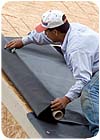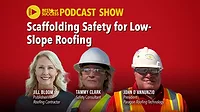TechnicalDetails: Underlayments for Steep-Slope Shingle Applications

Most roofing experts would agree that it is a best practice to apply underlayments on steep-slope shingle applications. Underlayments provide benefits to the roof system at the deck and shingle components. These benefits add to the long-term weatherproofing success of the roof system. Another primary reason for their use is that most building codes require the application of underlayments on steep-slope roofs. It is imperative that the contractors familiarize themselves with the codes in their work areas. Installations that are not completed in accordance with codes can be very costly to remedy, particularly in this case, where the remedy would include the removal of the steep-slope covering. Underlayments are also required to achieve a Class A fire rating for the roof system.
Underlayments serve as a weatherproofing barrier protecting the deck from moisture prior to shingle application and can be applied to dry in the roof in advance of the shingle installation. This is of particular importance on new construction projects, where there can be a lengthy lapse between deck installation and shingle application. Moisture absorption in the deck could lead to delamination or warping of the deck surface, providing an unsuitable long-term substrate.
In the completed system, the underlayment provides secondary protection against moisture infiltration, preventing water from entering the interior spaces if the shingles are lifted, displaced or torn. The underlayment also provides added protection to the applied shingles by separating the contact of wood resins and the shingles. Some wood resins can have an adverse effect on the shingles, contributing to deterioration over time. Underlayments also serve in leveling the deck by bridging over any slight irregularities and creating a flat and even surface for the shingle application.
Types of Underlayments
Underlayments used in steep-slope applications are generally one of four material classifications: organic felts, fiberglass mats, composites, or modified bitumen sheets. The most common type of steep-slope shingle underlayments are asphalt-saturated nonperforated organic felts. There are two designations of these sheets: Type 15 (No. 15) and Type 30 (No. 30). The designation denotes the once-used pound per square foot weight of the material. The sheets are manufactured in a multi-step process using an organic mat, fiberglass mat, or a combination of each. The initial process involves saturation of the sheet, which is accomplished by impregnating the fibers of the dry felt with asphalt and filling all voids. The next step is the coating process, which is completed by applying mineral stabilized coating asphalt to the top and bottom of the sheets. In some cases, a final step of a mineral surfacing application is completed to one or both sides of the sheet. Eaves flashing or "ice shield" protection is typically manufactured from self-adhered modified sheets or coated felts.
Most underlayments are distributed in rolls that are 36 inches wide. However, specialty underlayments are manufactured for specific applications. For instance, 18-inch rolls are produced for use as interlayments on wood shake applications.
Underlayment Application Procedures
Underlayments should always be applied over dry substrate surfaces. Moisture on the surface or entrapped in the substrate may enter the underlayment. Wet underlayments can contribute to shingle damage by creating blisters, buckling or wrinkling of the shingles. The deck substrate should be relatively flat, rigid and free of irregularities such as openings, cracks, deformations and delamination. All irregularities should be corrected prior to the installation of the underlayment.Prior to underlayment application, local codes should be reviewed to determine the proper underlayment attachment methods and if eaves flashings are required. These circumstances are guided by geographic boundaries. Eaves flashings are typically required in Northern climates, and strict fastener attachment is required in high-velocity wind zones. Application should be completed in accordance with the manufacturer's latest printed specifications.
Underlayment application should begin parallel to the eaves and should completely cover the entire deck area. Each course should overlap the preceding course by a minimum of 2 inches. If two or more pieces are required to complete a full course, the end laps should be a minimum of 4 inches. The end laps should be staggered throughout the installation, with end laps in succeeding courses a minimum of 6 feet from the end laps in the succeeding course. At all hips and ridges, the felt should be set a minimum of 6 inches on each side of the slope and it should be extended a minimum of 4 inches up all vertical surfaces. The underlayment should be laid flat and be free of all wrinkles and depressions, providing a smooth surface for the shingle application.
The most common attachment method is mechanical fastening to the substrate. The appropriate fastener/nail depends on the type of substrate and the manufacturer's specific requirements. Attachment methods should be determined by specific wind uplift requirements in the geographic location. Typical application rates over wood decks are one fastener every 9 inches at the side laps and two rows of fasteners in the middle rows staggered every 18 inches on center. In recent years, self-adhered underlayments have become more prominent in the industry and may be used in certain geographic zones.
Looking for a reprint of this article?
From high-res PDFs to custom plaques, order your copy today!




